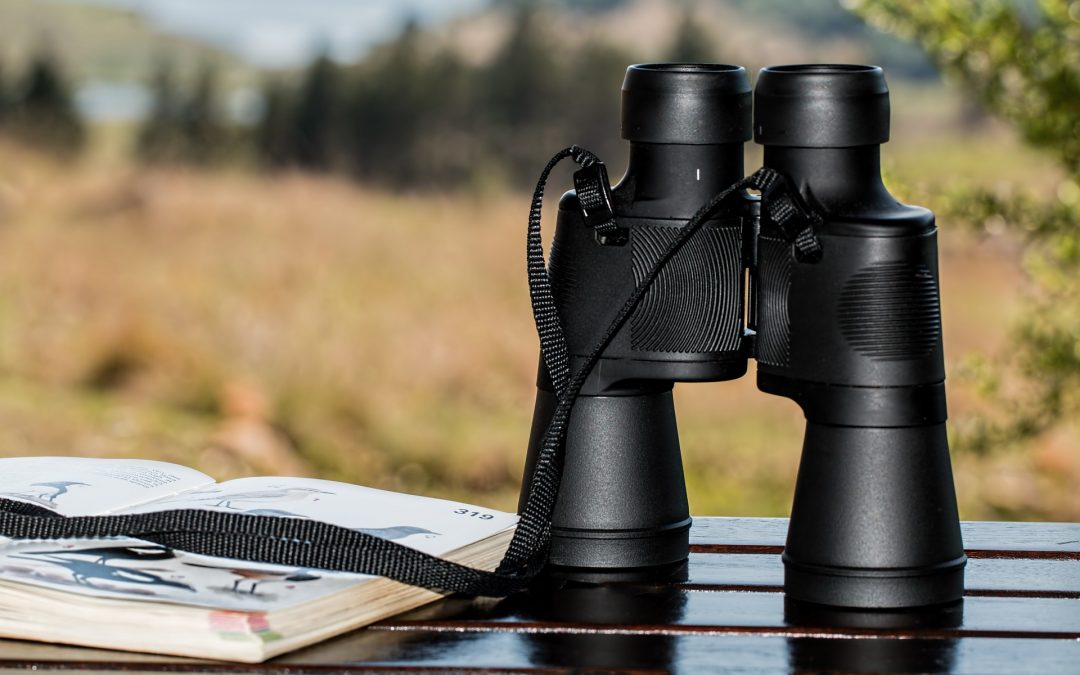If you want to buy binoculars but you have no idea how to choose the right ones, this article is for you. You’ll understand the the best binoculars for stargazing or for bird watching aren’t necessarily as good for travel, for theater, or for sporting events.
Learning how to buy binoculars is a matter of understanding what the numbers on binoculars mean and how they influence the viewing experience. Once you understand the meaning of these specifications, you’ll know how to choose binoculars like a pro. Here’s what to look for when buying binoculars:
- magnification
- field of view
- exit pupil
- size
- shape
- weight
- glass quality
- focusing type
- weatherproofing.
Keep reading to see what the numbers on binoculars mean and how they determine what’s the best use for different values.
What Do the Numbers on Binoculars Mean?
If you’ve been already looking to buy binoculars, you may have noticed some numbers written on all of them such as 7 x 35, 8 x 15, 8 x 30, 8 x 40, 10 x 50, etc. By understanding the meaning of these numbers and the way they influence your actual experience, you’ll be able to know what to look for in the best pair or binoculars in order to ensure maximum satisfaction. I’ll explain you he basics here, below. Should you be willing to know more, check out this article on B&H Photo; it is very clear and concise, and it illustrates all these concepts in a brilliant manner.
You’ll be able to find these numbers on the body of the binoculars. In most cases, they are engraved near the eyepiece.
Magnification
The first number is the strength of the magnification. If you see an 8, this means those binoculars bring the subject 8 times closer to you. You should keep in mind that binoculars don’t enlarge subjects but rather bring them closer to the viewer. If you have basic knowledge of how perspective works, you should understand that subjects that are closer to us appear bigger than the same size subjects that are farther. You may be tempted to believe that the higher the magnification, the better. However, extremely powerful binoculars may not be the best choice for observing subjects that are relatively close to you, as you won’t be able to see them as a whole. A higher magnification translates into a smaller field of view. Besides, at high magnification values, the binoculars become very difficult to hold still. The result will be a shaky image that’s going to make you dizzy.
Objective Size
The second number is the size of the objective lens. It is measured in millimeters and it is actually the diameter of the lens. The bigger it is, the more light is allowed to enter the device, thus improving the viewing experience. Nonetheless, smaller size lenses result in more compact binoculars for birding, safari, and other travel adventures that require packing light. When you do your shopping around for the best binoculars, you need to find the middle way, so that you can have the magnification power and the image clarity you want, without compromising on the portability of your binoculars.
The key to choosing the best binoculars is to find the ideal compromise between magnification, objective size, and the shape of your device.
Exit Pupil
Exit pupil is a parameter that reflects how bright an object will appear when observed in low lighting conditions. It is expressed in millimeters.
Most probably you won’t find this value written on the body of the device, but you can calculate it with ease. Just divide the objective size by the magnification and you’ll have the exit pupil value. For instance, 10 x 50 binoculars have an exit pupil of 5mm.
Knowing the exit pupil is very important, because this parameter correlates with the diameter of your pupil, thus having a direct influence on your viewing experience. If you want to buy binoculars that work great in dim light, you should go for an exit pupil of 5mm or more. In very dim light, the pupils of our eyes will dilate to reach up to 7mm in diameter. If you intend to use your binoculars in poor lighting situations, you should go for an exit pupil of minimum 5mm.
For daylight viewing, the exit pupil becomes irrelevant, as the human pupil will have an average diameter of 2mm. There aren’t any binoculars with an exit pupil smaller than 2mm, so you’ll be on the safe side regardless of your choice.
Field of View
The binocular field of view refers to the width of the area you’ll have in sight at 1,000 yards from the observation point. The binocular field of view is expressed in yards. A wider field of view is best for bird watching, as it eases your endeavor to find those birds in their surrounding environment. Unfortunately, the higher the magnification power, the narrower the field of view. You’ll need to find the compromise that would work best for you.
What Other Features of Binoculars Can Influence the Purchasing Decision?
If you look on the binoculars reviews websites, you may notice that similar pairs of binoculars have very different prices. Another thing to keep in mind is that two pairs of binoculars with similar magnification power can be radically different in size and weight. Here are a few features that can influence the size, the performance and the price of binoculars.
Lens Coating & Quality
The quality of the lenses has a direct influence on the amount of light that passes through the optical system of the binoculars to reach your eyes. In poor quality lenses, part of the light that hits the lens is reflected, the eye receives less light, and therefore the image appears darker. High-quality lenses with top-notch coatings are almost free from chromatic aberrations, reflections and distortion, hence offering a better image, particularly in low light situations. Fully multi-coated binocular lenses have the ability to cut almost all glare and all reflections while also increasing the light transmission through glass.
Beware, though, binoculars with high-quality lenses tend to be quite pricey, so make sure you really want to spend that much money before investing time and effort in research.
Eye Relief
The eye relief is the optimal distance between the eye and the eyepiece that enables you to obtain a sharp and clear image. If you wear glasses, it may be difficult for you to adjust the relative position of the eyepieces in a manner that enables you to achieve clear vision. The good news is that most brands of binoculars offer dioptric adjustment of the eyepieces, in order for you to make the necessary correction for a clear vision. Most of the time, you’ll find this diopter adjustment on one of the eyepieces. The eye relief may range anywhere between 5mm and 23mm. Should you want to use your binoculars with your glasses, you’ll have to ensure you get a device with at least 15mm eye relief and to roll down the eyecups. This will ensure the maximum field of view your binoculars are capable of.
Why Buy Binoculars?
Since good binoculars are expensive, you’re absolutely right to ask yourself whether you really need them or that’s going top be just another expensive purchase you’ll seldom use. If you love bird watching, you probably have your answer already. How can you see those lovely creatures from close, other than with a good pair of binoculars? Birding and wildlife watching aficionados should invest in binoculars, as they will get their reward from the very first day of using them. By researching and buying the best binoculars for bird watching, you’ll have the opportunity to enjoy your purchase in a wide array of situations.
Sometimes, you may need to use binoculars for safari only occasionally, as you may not go on a safari trip too often. In such situations, you should check whether the travel agent or the tour operator can supply you with proper equipment for the trip. However, chances are none of them will offer you binoculars with camera or devices that cost more than the actual value of your trip.
If you travel a lot, you should probably search for the best compact binoculars you can afford. Traveling with bulky gear can be tricky, particularly if you use low cost airline companies a lot. Besides, hiking for a full day with a heavy device around your neck isn’t meant to make you feel at ease. People who are very active may prefer to compromise on some features in favor of a compact device that easily fits into their pocket. Some may even prefer binoculars that take pictures, in order to avoid carrying too much gear around.
Astronomy or stargazing is another hobby that calls for the right equipment to complement your eyes. Whether to choose binoculars for stargazing or a powerful telescope is up to you to decide.
While you won’t need to buy the best binoculars and pay a small fortune to enjoy your hobby, you’ll still need to ensure your choice will suit the specific purpose that made you search for binoculars in the first place.The best binoculars for bird watching are not the same as the best binoculars for astronomy. you have to know the difference between the various activities, in order to be able to make an informed choice.
By reading buying guides, you can gain a better understanding of what to look for in a reliable pair of binoculars in each of the above mentioned situations.
Before delving into the meaning of the various features and parameters, keep in mind that finding the best binoculars for the money is a matter of individual study and side-bu-side comparison of all brands that are available on your market. Furthermore, the success of your endeavor relies quite heavily on reading binoculars reviews, either on Amazon or on any third party reviews website.


